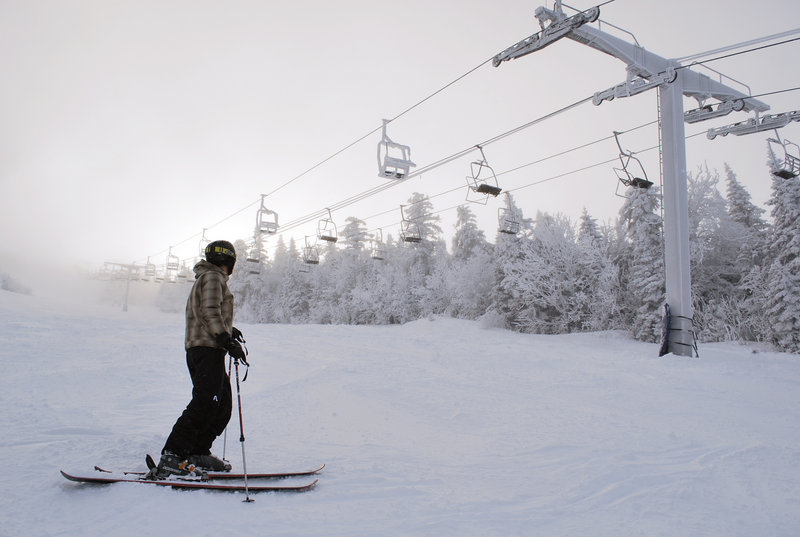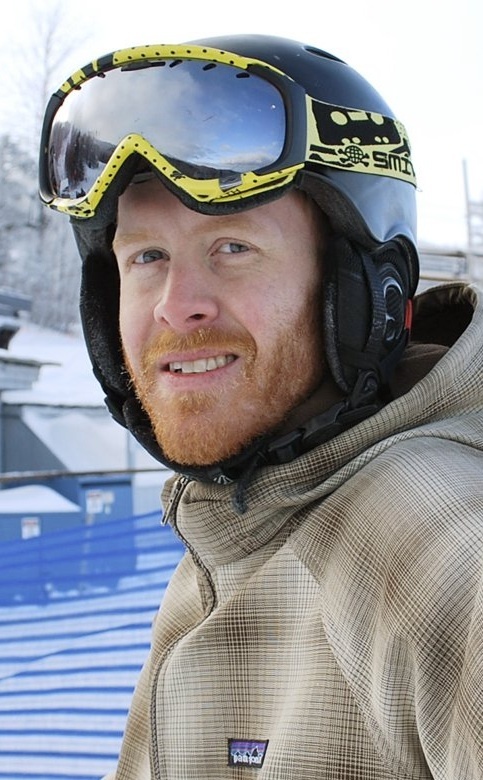The chairlift that derailed at the Sugarloaf Mountain Resort in late December had just passed a deadline for a comprehensive safety test.
So-called load tests are required for every Maine chairlift at least once every seven years. The last load test on Spillway East was done on Dec. 4, 2003, according to the resort and the Maine Elevator and Tramway Board.
That was seven years and 3½ weeks before the lift’s cable came off a 30-foot-tall tower Dec. 28, dropping five chairs to the snow and sending eight skiers to hospitals.
The chief inspector for the tramway board had approved the delay, a spokesman said, so Sugarloaf doesn’t face any state penalty.
An investigation of the accident continues, so it’s not known whether a load test last summer or fall might have uncovered any mechanical problems related to the derailment. Wind was quickly identified as a likely factor, but state investigators have since been looking closely at the mechanical components of the 35-year-old lift to figure out why it derailed and why backup equipment failed to catch the cable and keep the chairs from falling.
The fact that the accident occurred after the seven-year testing deadline had passed might become a factor in any liability claims against Sugarloaf and its insurer.
“Their duty is to ensure that lifts are safe for their skiers,” said Benjamin Gideon, a Lewiston-based attorney who represents five skiers injured in the accident. “There’s a reason (experts) chose that seven-year period. … It probably wasn’t arbitrary.”
Gideon said he had not yet analyzed inspection records or drawn any conclusions about whether Sugarloaf took “reasonable care.”
An overdue test does not mean Sugarloaf was out of compliance with state rules, according to the state. But representatives of other Maine ski areas, and regulators in neighboring states, said they make sure to comply with the seven-year standard.
A spokesman for Maine’s tramway board said the agency effectively granted an extension of the seven-year requirement when the state’s chief inspector agreed to a testing schedule set by Sugarloaf that included a load test of Spillway East this year.
“Although tramway owners are responsible for having load tests conducted, the state’s inspectors have been in communication with Sugarloaf and the other ski areas regarding this testing. It was understood and approved that a load test would be conducted on Spillway East in 2011,” Doug Dunbar said in an e-mail response to questions. “The elevator and tramway program has authority to grant variances to its rules, including extension of the seven-year time frame for load tests.”
Chief Inspector John Burpee, who approved Sugarloaf’s test schedule, has declined to answer questions about the tramway board or the accident at Sugarloaf during the investigation.
Sugarloaf’s lift manager was not available to be interviewed, said Ethan Austin, Sugarloaf’s spokesman.
Austin said the test of Spillway East was on a schedule presented to the tramway board in 2008. It was one of six chairlifts that would be due for testing by the end of 2010.
“We knew that 2010 was coming up so we got with the tramway board to create a schedule,” Austin said.
There was no particular reason why Spillway East was scheduled for 2011 instead of 2010, except that the resort wanted to create a sustainable rotation of two or three load tests each year, Austin said. State officials “were comfortable with that schedule,” he said.
The 2003 load test on Spillway East, and the annual inspection done last fall, revealed no significant safety issues, he said.
“I can say the lift was inspected prior to the season and it was properly licensed by the state,” Austin said. “Everybody was comfortable operating it at the start of the season and was comfortable with the load test” being done in 2011.
It’s too soon to say whether a load test last year might have helped avert December’s accident, Austin said. “We won’t know that until the investigation is done and the report is issued,” he said.
Load tests are usually done in the off-season, when workers can take the time needed to test the various motors and brake systems, and check the operation of the sheave trains that carry the cable over the towers. It can take a day or more to test a single lift. The tests are overseen by private, state-licensed inspectors who are hired by the resorts or their insurance companies. Reports are made available to the state.
Lift mechanics typically load each chair with a water-filled box until the lift is loaded to capacity, or slightly more than full capacity. Then they test each motor and brake system, recording operating speeds, stopping distances and other details, such as misaligned sheave trains.
The tests also are required whenever lifts are installed or significantly upgraded. The 2003 load test of Spillway East, for example, was done after a new drive was installed.
States with ski industries began requiring the seven-year load tests in 1999. Maine adopted the requirement in 2003.
Dunbar, the tramway board spokesman, said extensions such as the one for Spillway East were not unusual as the Jan. 1, 2010, deadline approached for the first round of tests.
“When reasonable and appropriate plans have been presented, extensions have been granted to New Hermon, Lost Valley, Sugarloaf, Sunday River and Mt. Abram,” Dunbar said.
Some extensions have been related to changes in ownership, he said.
Representatives of other Maine ski resorts, while not commenting on Sugarloaf’s lift, said they consider the seven-year requirement to be strictly enforced. The rule is a national guideline developed by the National Ski Areas Association and published by the American National Standards Institute in 1999.
“That’s cut and dry,” said Jim Quimby, operations director at Saddleback Mountain. “They have to be done at least every seven years, and then when there is certain types of work done on a lift,” a load test also is required. “You’re not going to bypass a critical ANSI standard like a dynamic load test.”
All of Saddleback’s chairlifts have been tested within the past seven years, he said.
“That’s just part of what every ski area does,” said Ed Rock, general manager of Shawnee Peak. “We’ve done all of the prescribed load tests here. I know everybody, at least in this state, takes it very seriously.”
“Our load testing is done at a minimum of every seven years,” said Darcy Morse, spokeswoman for Sunday River, which is operated by the same company as Sugarloaf, Boyne Resorts.
Morse said Sunday River tested 11 chairlifts last summer and fall to comply with the state deadline.
Dunbar, however, said Sunday River also was granted an extension, and that at least some of the tests that were done last year should have been done before Jan. 1, 2010.
“Some of Sunday River’s load tests … would have been overdue, if the extension had not been granted,” Dunbar said in an e-mail.
Sugarloaf’s testing schedule shows that its managers were well aware of the deadline and, for the most part, met it.
Spillway East, as it happens, was an exception. Eleven of Sugarloaf’s 13 chairlifts have been load tested in the past seven years.
The only other chairlift at Sugarloaf that has not been tested since 2003 is the West Mountain lift. That lift generally operates only on weekends, and primarily carries skiers from the West Mountain condominiums, said Austin. It is scheduled to be load tested this year.
It is unusual for any chairlift to go beyond seven years without a load test in other northern New England states, according to head inspectors in New Hampshire and Vermont.
“We schedule them out. We don’t let them get (behind),” said Robert McLeod, Vermont’s passenger and tramway manager. “Those things are really important because you’ve got stopping distances that have to be met” and other requirements. “It’s not a surprise thing (for ski areas); they know it’s going to happen.”
New Hampshire’s tramway board requires a seven-year load test before a chairlift starts up.
“I don’t believe, in New Hampshire, we have had any that operated beyond seven years” without the test, said Briggs Lockwood, chief inspector for the Bureau of Tramway and Amusement Ride Safety. “We would require that it be done before it operates again.”
Because of the accident in December, Spillway East will get its next load test sooner than scheduled.
A comprehensive load test will be a final step before the mountain is allowed to reopen the lift, Dunbar said. It could be done as soon as next week, depending on weather and other ongoing tests.
Staff Writer John Richardson can be contacted at 791-6324 or at:
jrichardson@pressherald.com
Send questions/comments to the editors.




Success. Please wait for the page to reload. If the page does not reload within 5 seconds, please refresh the page.
Enter your email and password to access comments.
Hi, to comment on stories you must . This profile is in addition to your subscription and website login.
Already have a commenting profile? .
Invalid username/password.
Please check your email to confirm and complete your registration.
Only subscribers are eligible to post comments. Please subscribe or login first for digital access. Here’s why.
Use the form below to reset your password. When you've submitted your account email, we will send an email with a reset code.